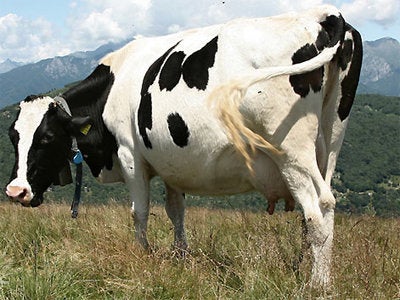
Last week, the U.S. Department of Agriculture's Office of Inspector General released its long-awaited audit of slaughter practices and procedures, launched after The Humane Society of the United States uncovered rampant cruelty to sick and crippled cows at the Hallmark/Westland meat packing plant in Chino, Calif., earlier this year.
The report inexplicably claims that the abuses which led to the largest meat recall in U.S. history are not "systemic" in the industry, but then goes on to explain numerous ways that similar problems could be occurring at other plants. At a time when agribusiness operations knew they were under heightened scrutiny and were arguably on their best behavior, the investigation still found dangerous gaps in the system. As Neil Nisperos reported in the Inland Valley Daily Bulletin and San Bernardino County Sun:
The OIG concluded there was an "inherent vulnerability" for handling violations to occur and not be detected by USDA inspectors because the agency does not provide continuous surveillance of all areas in a slaughter establishment.
The investigation also found several veterinarians who took shortcuts in ante-mortem inspections in order to complete assigned tasks. Such shortcomings made it possible for problems to be missed.
It's clear that lax agency enforcement of humane slaughter rules continues to allow unacceptable abuse of animals and food safety risks. It's an issue to which the incoming Obama administration and the new Congress must be attentive, as we urgently need stronger oversight and reform to prevent inhumane treatment of animals, reduce the risks of foodborne illness and boost consumer confidence in the food supply.
The OIG audit focused on "cull cattle" plants which, like Hallmark/Westland, specialize in slaughtering "spent" dairy cows -- those who have been pushed to their limits of milk production and are generally in weaker physical condition than other cows. One of the most shocking revelations in the new report is that four of the facilities investigated supply meat to processors who provide nearly 60 percent of all ground beef to the National School Lunch Program.
When the public first saw images of crippled cows being abused with bulldozers, electric prods, and water hoses, people were horrified to learn that meat from this one particular plant -- which had been named the USDA "supplier of the year" for the 2004-2005 academic year -- was being served to thousands of school children in 47 states. Now we know that an overwhelming amount of ground beef in school lunches still comes from cull cattle plants -- where cows are more likely to be too weak and sick to stand up and walk on their own.
A review of new scientific studies reveals just how dangerous this current practice is not only for animals but also for school children. In the August 2008 issue of the Journal of Food Protection, USDA researchers report that after analyzing more than 1,000 beef samples, half from cull cattle slaughter plants and half from regular plants, they found more than three times the presence of Salmonella in the cull cattle meat. Also, all of the multidrug-resistant Salmonella they found came from cull cattle.
In October 2008, a different set of USDA researchers sampled carcasses at cull cattle slaughter plants across the country and found an astounding 94.3 percent of cull cattle hides contaminated with either E. coli O157:H7, Salmonella, or both. They then documented the transfer of these pathogens from the hides to the carcasses through to the end of the process. The potentially deadly strain of E. coli O157:H7 is the leading cause of acute kidney failure among school children in North America, and Salmonella is another leading foodborne killer.
Our schools have become a dumping ground for cheap meat, and it's coming from the very slaughter plants where the animals are more likely to be sick and injured, and the meat is more likely to be contaminated. The most vulnerable populations of our society are subjected to the lowest-grade food with the highest-grade risk.
It's a disgrace that nearly a year has passed since the Hallmark/Westland scandal, with agencies and businesses not doing much differently when it comes to school lunches or slaughter practices. Lawmakers and federal regulators need to do better for farm animals and for children, and usher in a whole new era of oversight and reform for food safety and humane treatment.
